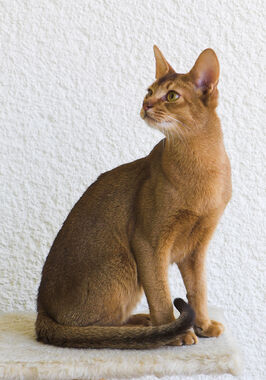The Abyssinian ( /æbɨˈsɪniən/) is a breed of domesticated cat with a distinctive ticked coat. There are many stories about its origins, often revolving around Ethiopia, but the actual origins are uncertain. The

Abyssinian has become one of the most popular breeds of shorthair cat in the USA.
History
The name 'Abyssinian' refers to Ethiopia, but most of the stories about the origins of Abyssinians refer to Egypt. Genetic research suggests the breed originated near the coast of the Indian Ocean, where colonists may have purchased animals from wild animal traders. The breed was developed in Egypt.[1]
The breed is sometimes believed to have originated from one Egyptian female kitten named Zula, who was taken from a port in Alexandria by a British soldier and brought to England in 1868. This theory is not established because there is no solid link between Zula and the cat first listed as an Abyssinian in 1882.[3]
Many sources repeat the story that the Abyssinian breed is a few thousand years old and comes from Ancient Egypt, as the cats resemble those in ancient paintings. Ancient Egyptians made sculptures of them. There are also stories that wild 'Abyssinians' live in parts of North Africa today
Description
The coat is medium-length, dense, and silky to the touch. The Abyssinian, and a similar long-hair breed called the Somali, have coats that are unusual enough to catch attention. These felines owe their special coat to one dominant mutant gene known as Ta. Each hair has a base color with three or four darker-colored bands; the hair is the lighter colour at the root, and the darker "ticking" color at the tip. This ticking is found only in the Somali, Abyssinian and Singapura.
The first cat to have its entire genome published was an Abyssinian named Cinnamon.[4]
The original Abyssinian coat colour is known as 'Usual' in the United Kingdom and as 'Ruddy' elsewhere. The coat has a warm reddish-brown base, with black ticking. The feet and the backs of the hind legs are always black.
Over the years, various other colours have been developed from this original form, but the markings on the coat have remained the same. The back of the hind legs and the pads of the paws are always darker than the rest of the coat. A popular colour is Sorrel, which has a cinnamon (yellowish-brown) base, with chocolate brown ticking, paw pads and backs of the legs. Blue Abyssinians, which have become increasingly popular in recent years, have a light beige base colour with blue ticking, paw pads and backs of the legs. The relatively rare Fawn Abyssinians have a light-cream base colour, with darker cream ticking and warm dark cream pads and backs of the legs
Silver Abyssinians are a separate group among the breed. Although this colour has been in existence for decades, it is not recognised by the Cat Fanciers' Association, the world's largest registry of pedigreed cats. In Silvers, the undercoat is always a pure silvery white. The markings include black, blue, warm dark cream and cinnamon. Purely Silver Abyssinians are difficult to breed because they sometimes have undesirable tan patches in the coat. In addition to this, any spots in the coat show up more clearly on a silver coat.
Rare colours include the Tortoiseshell, Red, Cream, Chocolate and Lilac, which are all bred on a small scale in the Netherlands and the United Kingdom.[citation needed]
Abyssinian kittens are born with dark coats that gradually lighten as they mature. It usually takes several months for the final coat color to be established. Temperament
Abyssinians are extroverted, extremely active, playful, wilful and intelligent. They are usually not "lap cats", because they are usually too preoccupied with exploring and playing.[5] They are popular among breeders and owners, and can be very successful show cats. Not all Abyssinians are shown, however, because the color and type standards are very exacting, and because some are shy towards strangers and timid in public. They have quiet, engaging voices.
"Abys", as they are affectionately referred to by their fans, need a great deal of love and interaction with the family to keep them happy and can get depressed without daily activity and attention.[3] They generally get along well with other cats, although they need their space and the females can sometimes be irritable around other cats. Abyssinians are known for their curiosity and enjoy exploring their surroundings, including heights. They are sensible cats that do not take unnecessary risks. As one might expect from such an intelligent and physically capable breed, Abyssinians are known to be formidable hunters. They adore toys and can play for hours with a favorite ball. Some play fetch.
Health
Abyssinians are pretty easy to groom. It will need an occasional bath and brushing. It can be prone to gingivitis, so it will need its teeth brushed. Renal Amyloidosis, a kidney disorder, has been seen in Abyssinians.